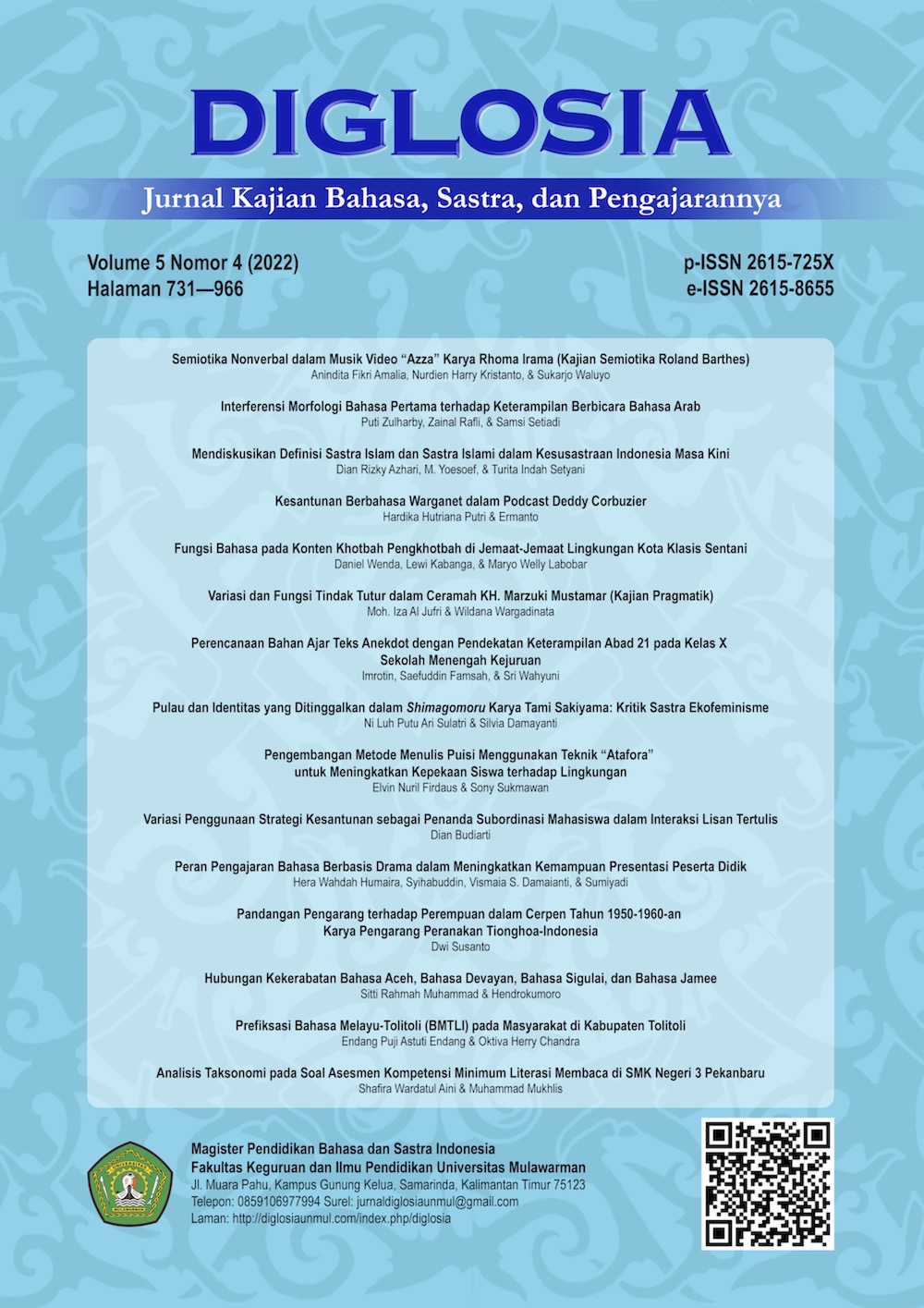Prefiksasi Bahasa Melayu-Tolitoli (BMTLI) pada Masyarakat di Kabupaten Tolitoli
Main Article Content
Abstract
The Malay-Tolitoli (BMTLI) language is unique, especially in the field of morphology. This study aims to determine the prefix and its application in Malay-Tolitoli (BMTLI). This research was conducted using a generative morphology study with a model developed by Halle, namely the IP model (Item and Process), with data derived from interviews and observations of native speakers. The results of this study indicate that in the Malay-Tolitoli (BMTLI) language, there is a derivation process in the use of the prefix "Ba-" where there is a change in word class that changes the noun into a verb, and adjectives become verbs. However, the derivation process does not occur between verbs and verbs. This study also shows that the prefix "ba-" is always followed by a derivative verb. The prefix "ta-" in Malay-Tolitoli (BMTLI) is always followed by a verb used to indicate passive sentences without changing the word class, and the use of the prefix "mo-" is always followed by a transitive verb, and the prefix "moba-" is always followed by an intransitive verb in its use without changing the word class. These two prefixes only show the meaning "ingin" (want).
Downloads
Article Details
![]()
Every work in Diglosia: Jurnal Kajian Bahasa, Sastra, dan Pengajarannya is licensed under a Creative Commons Attribution-ShareAlike 4.0 International License.
Under the following terms:
- Attribution — You must give appropriate credit , provide a link to the license, and indicate if changes were made . You may do so in any reasonable manner, but not in any way that suggests the licensor endorses you or your use.
- ShareAlike — If you remix, transform, or build upon the material, you must distribute your contributions under the same license as the original.
- No additional restrictions — You may not apply legal terms or technological measures that legally restrict others from doing anything the license permits.
Authors who publish with this journal agree to the following terms:
- Authors retain copyright and grant the journal right of first publication with the work simultaneously licensed under a CC BY-SA 4.0 DEED Attribution-ShareAlike 4.0 Internationalthat allows others to share the work with an acknowledgment of the work's authorship and initial publication in this journal.
- Authors are able to enter into separate, additional contractual arrangements for the non-exclusive distribution of the journal's published version of the work (e.g., post it to an institutional repository or publish it in a book), with an acknowledgment of its initial publication in this journal.
- Authors are permitted and encouraged to post their work online (e.g., in institutional repositories or on their website) prior to and during the submission process, as it can lead to productive exchanges, as well as earlier and greater citation of published work.
References
Baryadi, I. P. (2011). Morfologi dalam Ilmu Bahasa. Sanata Dharma University.
Boberg, C., Nerbonne, J., & Watt, D. (Eds.). (2018). The Handbook of Dialectology (1st ed.). Willey Blackwell.
Hartanti, M. W. (2022). Makna awalan {Ba-} Bahasa Melayu Manado. Journal Pendidikan & Konseling. Jurnal Pendidikan Dan Konseling (JPDK), 4(4), 1661–1671. http://journal.universitaspahlawan.ac.id/index.php/jpdk/article/view/5586
Hasanah, H., Setiawati, E., & Nurhayani, I. (2022). Afiksasi Verba Bahasa Madura Dialek Pamekasan berdasarkan Perspektif Derivasi dan Infleksi. Diglosia: Jurnal Kajian Bahasa, Sastra, Dan Pengajarannya, 5(3), 557–588. https://doi.org/10.30872/diglosia.v5i3.472
Igaab, Z. K., & Kareem, I. A. (2018). Affixation in English and Arabic: A Contrastive Study. English Language and Literature Studies, 8(1), 92–103. https://doi.org/10.5539/ells.v8n1p92
Kemendagri. (2017). Peraturan Menteri Dalam Negeri Nomor 137 Tahun 2017 tentang Kode dan Data Wilayah Administrasi Pemerintahan. https://peraturan.bpk.go.id/Home/Download/102462/PERMENDAGRI Nomor 137 Tahun 2017.pdf
Loe, E. E. Y. (2020). Prefixes “BA” and “TA” in Bahasa Melayu-Kupang. Atma Jaya Annual Linguistics Conference, September, 252–254.
Mahsun. (2021). Uncovering the Development of Bahasa Melayu Use within the Austronesian Family. In OR IPSH BRIN Indonesia.
Nur, T. (2018). Infleksi dan Derivasi dalam Bahasa Arab Analisis Morfologi. Metalingua: Jurnal Penelitian Bahasa, 16(2), 273–283. https://doi.org/10.26499/metalingua.v16i2.280
Prasetya, K. H., Subakti, H., & Septika, H. D. (2020). Pemertahanan Bahasa Dayak Kenyah di Kota Samarinda. Diglosia: Jurnal Kajian Bahasa, Sastra, Dan Pengajarannya, 3(3), 295–304. https://doi.org/10.30872/diglosia.v3i3.77
Rumilah, S., & Cahyani, I. (2020). Struktur Bahasa: Pembentukan Kata dan Morfem sebagai Proses Morfemis dan Morfofonemik dalam Bahasa Indonesia. Jurnal Pendidikan Bahasa Indonesia, 8(1), 70–87. https://doi.org/10.30659/j.8.1.70-87
Sande, H., Jenks, P., & Inkelas, S. (2020). Cophonologies by Ph(r)ase. Natural Language & Linguistic Theory, 38(4), 1211–1261. https://doi.org/10.1007/s11049-020-09467-x
Septiana, D. (2018). Proses Morfologi Verba Bahasa Waringin. Kandai, 14(2), 287–302. https://doi.org/10.26499/jk.v14i2.627
Simpen, I. W. (2021). Morfologi: Kajian Proses Pembentukkan Makna. Bumi Aksara.
Soulisa, I., Pormes, F. S., & Manuputty, P. (2020). Analisis Kata Bilangan Bahasa Abun Ragam ta Distrik Bikar Kabupaten Tambraw. Jurnal Akrab Juara, 5(1), 27–37. https://akrabjuara.com/index.php/akrabjuara/article/view/939
Waridah, E. (2015). EYD & Seputar Kebahasa-Indonesiaan. Kawah Media.

